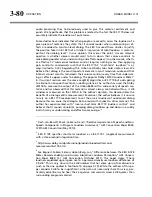
3-68
OPERATION
ORBAN MODEL 1101
order of a few milliseconds and is not user adjustable. The purpose of the
limiter is
only
to limit peaks that pass through the earlier compressors be-
cause of their finite attack times. Functionally it is used like a peak clip-
per, but it has vastly reduced modulation distortion by comparison to a
clipper, whether “soft knee” or “hard knee.”
The main potential side effects of the look-ahead limiter are gain breath-
ing and a “warbling” sound in the midrange when heavy bass is simulta-
neously present. Listen carefully for this intermodulation effect (particu-
larly on vocals) when you are adjusting the F
INAL
L
IMIT
control.
N)
Adjust the Bass Clip Threshold and Bass Clip Shape controls to complement
the amount of final limiting.
For most mastering applications, you can set the B
ASS
C
LIP
T
HRESHOLD
to
O
FF
. However, if you hear pumping or “warbling” distortion in the look-
ahead limiter caused by heavy bass transients, you can reduce this effect
by setting the B
ASS
C
LIP
to a lower level. (The B
ASS
C
LIP
control is calibrated
in “dB below the look-ahead limiter threshold.”) It is most effective when
the B1/B2
C
ROSSOVER
control is set to 100 Hz, as this setting prevents in-
termodulation between vocals and instrumental bass in the clipper.
O)
If you wish to compare your processed sound to the unprocessed original, re-
call the
L
OOK
A
HEAD
L
IMITER
preset and toggle between it and your processing
preset. If there is a gross loudness disparity, you may wish to edit the gain
within the
L
OOK
A
HEAD
L
IMITER
preset and save this as a user preset.
P)
Save your preset using File/Save Preset.
Once you have created one “mastering” preset, you can edit it to create
others and save them under different names.
Q)
For a 44.1 or 88.2 kHz output sample rate, set the digital output level in the
I/O Mixer to approximately –0.5dBfs; this will prevent overshoots caused by
sample rate conversion. For a 48 or 96 kHz output sample rate, set the digital
output level to –0.1dBfs.
At 44.1 kHz, the output samples are not exactly the same ones that the
look-ahead limiter controlled at the internal 192 kHz sample rate, so
slight overshoot can occur. Overshoot will never exceed 0.5 dB and will
typically be less than 0.1dB.
If your mastered audio is intended for transmission via a lossy codec like
AAC, MP3 or WMA, be aware that the codec’s decoder may overshoot
and cause audible clipping distortion. See
on page 1-36. If the 1101’s output is applied directly to a lossy co-
dec, decrease the setting of the 1101’s output level control to allow the
necessary headroom. If the 1101’s output is applied to a linear PCM stor-
age medium (like a CD), it is better to use the entire dynamic range of
the linear medium by setting the 1101’s output level close to 0 dBfs. Then
compensate for codec overshoots by reducing gain when you transcode
from the linear PCM recording to the codec.
Summary of Contents for Optimod-PC 1101
Page 4: ......
Page 14: ......
Page 121: ...OPTIMOD PC OPERATION 3 1 Section 3 Operation Figure 3 1 The OPTIMOD PC Control Application...
Page 192: ...3 72 OPERATION ORBAN MODEL 1101...
Page 204: ......
Page 210: ......
Page 212: ...5 2 UNINSTALLATION ORBAN MODEL 1101...
Page 236: ......
















































